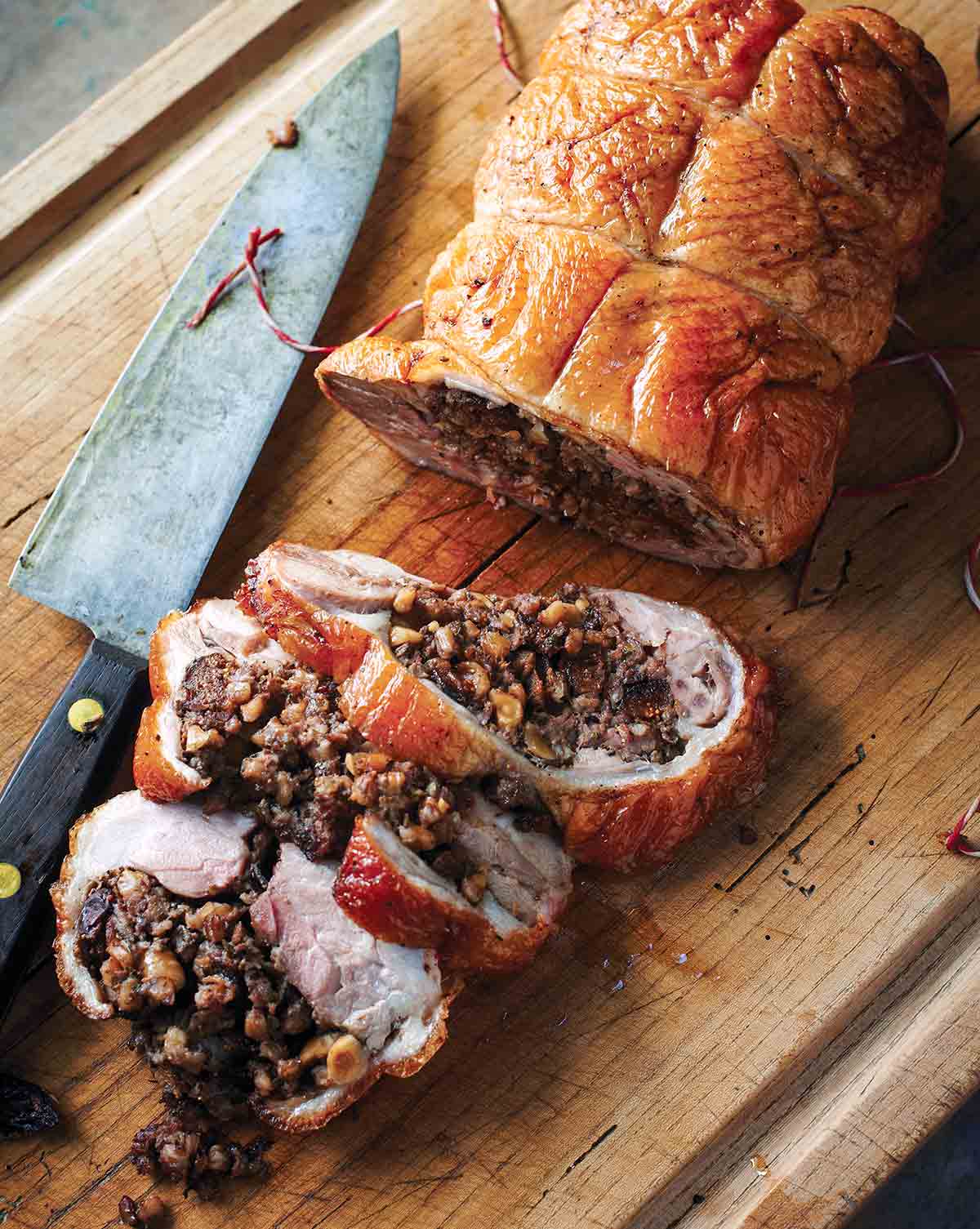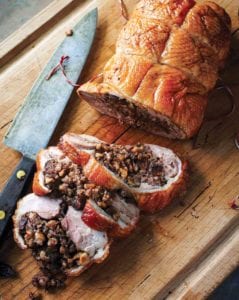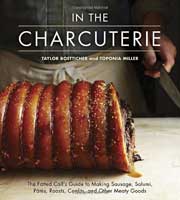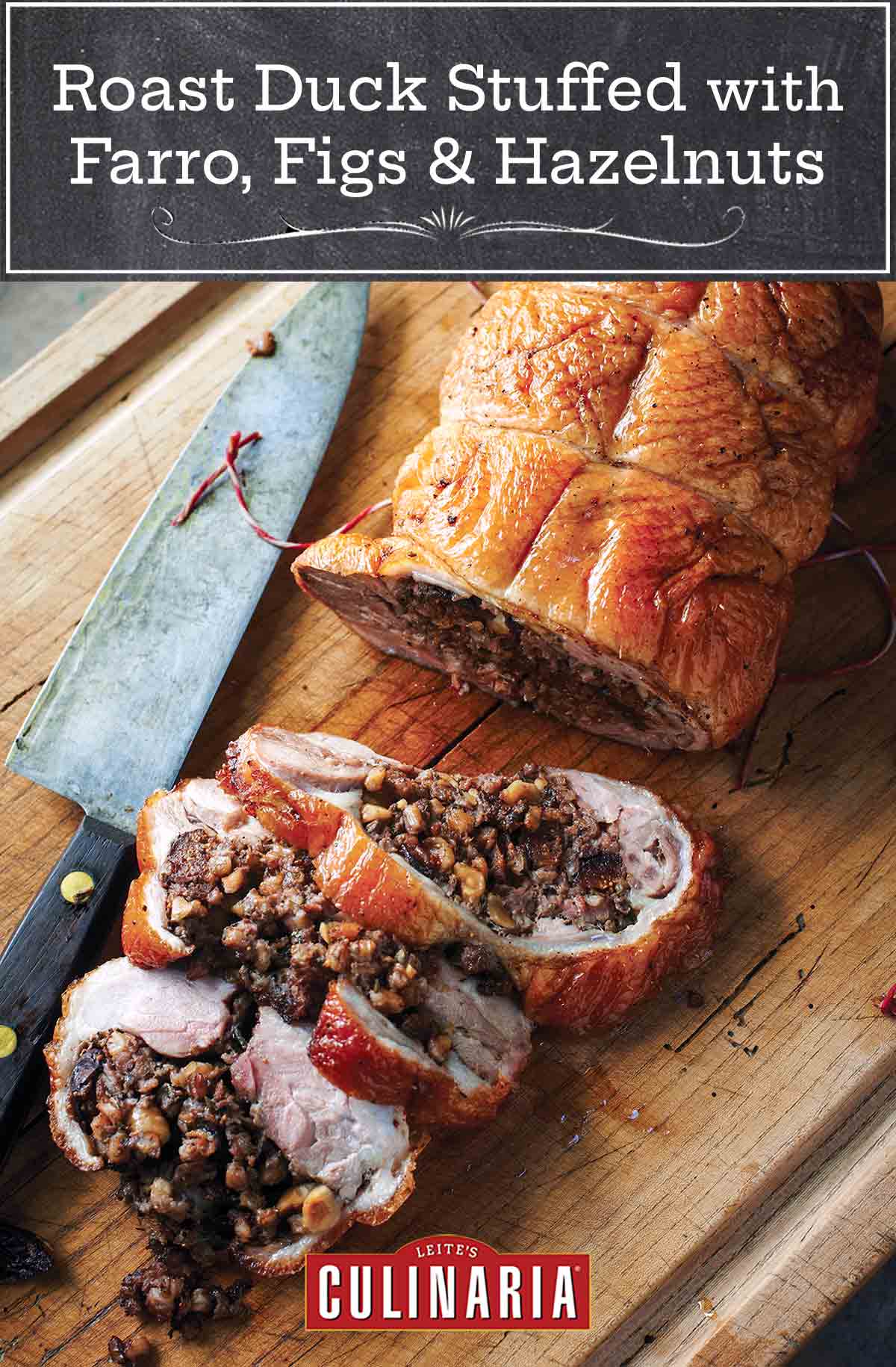
Farro, an ancient varietal of wheat popular in central Italy, is a favorite in the Fatted Calf kitchen, where we add it to hearty soups and rustic salads. When cooked, it has a firm but chewy texture that also makes it perfect for use in stuffings.—Taylor Boetticher | Toponia Miller
Roast Duck Stuffed with Farro, Figs, and Hazelnuts FAQs
If you’re up for a small challenge, like our recipe tester Elie Nassar was, you can do the deboning yourself. It looks more daunting than it actually is. “If you’re proficient with your knife and have 20 to 30 minutes, it’s a really satisfying experience,” Nassar explains, citing this how-to video for helping him get Sunday’s dinner on the table. If you’d rather not, you can ask your butcher to debone the duck, although you best smile sweetly and ask well in advance of when you need it. Just be aware that there may be a rather steep charge for this courtesy.
If you’d rather, you can simply roast the duck whole—bones and all—and turn the stuffing into dressing and bake it on the side. (See the Variation below for instructions.) You know, like a turkey or chicken.
You can! The authors of this recipe assert that although they like the toasty, nutty flavor of farro in combination with roast duck, this stuffing works equally well with roast quail, game hens, or other birds. Even turkey.

Roast Duck Stuffed with Farro, Figs, and Hazelnuts
Equipment
- Kitchen string
Ingredients
- 1 1/2 cups dry red wine, such as pinot noir
- 2 tablespoons granulated sugar
- 1 dried bay leaf
- 1 sprig thyme, plus 2 tablespoons chopped thyme leaves
- 1/2 teaspoon whole black peppercorns
- 1 allspice berry
- Fine sea salt, to taste
- 12 dried figs, (any variety)
- One (5- to 7-pound) whole duck, deboned (see LC Note above)
- Freshly ground black pepper, to taste
- 1 pound breakfast sausage, uncooked
- 2 cups cooked farro, (or substitute wild rice, brown rice, or mixed whole grains)
- 3/4 cup hazelnuts, toasted, skinned, and coarsely chopped
- 1/2 cup chopped flat-leaf parsley leaves
Instructions
- A day before dinner, in a small saucepan over medium-high heat, stir together the wine, sugar, bay leaf, thyme sprig, peppercorns, allspice, and a pinch of salt. Bring to a simmer and stir until the sugar dissolves. Remove from the heat, add the figs, and cover. Let cool to room temperature and then refrigerate overnight.
- A couple of hours before dinner, preheat the oven to 375°F (190°C). Fit a roasting pan with a rack.
- Trim any glands or blood vessels from the duck. Pat the duck completely dry with paper towels and place it on a cutting board, opening it like a book. Season it inside and out (that is to say, on both the meat and the skin) with salt and pepper. Turn the duck skin side down.
- Drain the figs, trim the stems, and then quarter each fig lengthwise. In a bowl, combine the figs, sausage, farro, hazelnuts, chopped thyme, and parsley. Pat the stuffing into a cylinder about 3 inches in diameter and 3 inches shorter than the length of the duck. Place the stuffing directly in the center of the duck and roll the meat tightly around the stuffing, tucking the ends underneath. Tie the duck every 2 inches or so with a separate piece of kitchen string.
- Using the tip of a sharp knife, lightly score the duck skin in a crosshatch pattern to facilitate the release of fat during cooking, being careful not to cut the string.
- Place the duck on the rack and roast it, basting the duck with the drippings that accumulate in the pan 3 or 4 times, for about 60 to 90 minutes, until a thermometer inserted into the middle of the farro stuffing registers 160°F (71°C). If the skin starts to get a little too brown, you can lower the oven temperature to 325°F (165°C) so the duck finishes more slowly.
- Remove the duck from the oven and let it rest for 10 minutes. Carve into slices about 1 inch thick, removing and discarding the string. Serve immediately.
Notes
Whole Stuffed Duck Variation
Can’t get anyone to debone that duck for you? No problem. What you want to do then is roast it whole—bones and all. Yup. Just pat the duck dry, season it with salt and pepper, and shove it in the oven. [Editor’s Note: If you lack a preferred technique for roasting duck, our recipe tester Elie Nassar roasted it on a rack in a roasting pan at 325°F (165°C) for 1 1/2 to 2 hours and it worked just dandy.] You could stuff the bird with the farro and hazelnut and fig goodness or you could instead plop the stuffing in a small baking dish and slip that in the oven alongside the bird for the last little while. (When making the stuffing, you’ll need to amend it slightly. Sauté the sausage until no trace of pink remains, then mix in the rest of the ingredients, spoon it into the cavity of the duck or an 8-inch square dish or small casserole covered with a lid or foil, and bake until warmed through, 30 to 60 minutes.) Easy peasy.
Explore More with AI
Nutrition
Nutrition information is automatically calculated, so should only be used as an approximation.
Recipe Testers’ Reviews
If you’re looking for something perfect for that special celebration, you’ve found it! Also called a ballotine, this is an incredible presentation of a roast duck recipe and makes for a grand entrance to your dinner table. I love the way that these rich flavors, colors, and textures all come together to exemplify what constitutes a great fall dinner or Christmas dinner, even. I served the duck with roasted root vegetables. The recipe for roasted root vegetables with Marcona almonds is a fine example of a side dish that further showcases fall bounty. It also seemed the obvious choice, since I was using my oven anyway.
If you’re handy with a knife, the duck can be deboned and ready in less than an hour. Be sure to season the duck well with salt and pepper, allowing the farro stuffing flavors to pop. Once stuffed and tied, the duck can be wrapped well and frozen in advance. Just be sure to take it out of the freezer at least a couple of days ahead of your meal so it can thaw properly.
As for roasting, my 5-pound duck took about 1 1/2 hours to reach the proper internal temperature. Once sliced, it easily served 6 people. You may not need all the stuffing mix. Once placed on the deboned bird, I started the roll with the breast-end, as the other end is thinner and fattier. That needs to be outside of the bird and helps with the closure and sealing at the end. I cross-hatched the skin, but thought later that pricking it well with a fork may be a better way to go.
All the breakfast sausage here in Canada is in casings, so I removed the casings and mixed them into the stuffing by hand. Chopping the hazelnuts can be time-consuming, messy, and somewhat dangerous. My solution was to place them in a resealable plastic bag, large enough to hold them in a single layer, and then use my meat mallet (the smooth side) to lightly pound them to the desired texture.
I absolutely loved this recipe. It really is very straightforward to prepare (more or less) if you’ve access to a deboned duck. I didn’t, so I did the deboning myself. The duck reaches about 140°F (60°C) in about 60 minutes. However, at that point, the skin was still a bit too light-colored for my liking. Also, since the filling has sausage, cooking it closer to 160°F (70°C) isn’t a bad idea. Sure enough, another 25 minutes gave me a beautiful, golden brown, crisp-looking skin and the filling had reached 160°F (70°C). That was perfect for my taste and the duck meat was flavorful and juicy.
The end result is an impressive roast with crisp skin, flavorful meat, and deliciously unique farro and sausage filling that’s sweet, salty, and robust with spices and herbs. The hazelnuts turn a bit soft, almost like chestnuts. With the duck and the hearty filling, you really have a full meal, but I did want something tart and green with it, so I served it with broccolini dressed in a mustard vinaigrette. We opened a bottle of pinot noir to go along with the meal—a great combo!
One last thing—the recipe leaves you with a good bit of unused spiced wine from soaking the figs. When I served the duck leftovers the next day, I sliced the figs into rounds and panfried them in a little duck fat until crisp. Then I reduced the spiced wine and swirled in some butter to make an excellent sauce.
After running around town from store to store like a maniac to find a 5- to 7-pound duck, I finally settled for 2 frozen 3 1/2-pound ducks. While going through the process of deboning the first duck, my patience grew shorter and I decided to leave the other intact to see how it’d come out. The deboned version was perfection after cooking and the stuffing was juicy and amazingly tasty, with a nice blend of sweetness, herbs, and spices.
I used quinoa instead of farro for the grain, as that’s what I had at home. The second version (the full, untouched duck) was just as juicy and tender but the stuffing came out a tad drier. I simply cannot explain why, unless it was because it took 30 more minutes in the oven to attain the correct temperature. This is certainly a recipe to redo; I’d love to try it with a goose.
Duck. Figs. Farro. Hazelnuts. Swoon. Watching the turning leaves outside my kitchen window while the scent of a roasting duck fills the air. Double swoon. As for the flavor, the wine-soaked figs work in complete harmony with the duck, while the hazelnuts provide a delightfully toasty crunch. I made my stuffing with wild rice and loved the texture against the sausage.
Who knew it was so easy to wow your loved ones with a truly impressive dish without a lot of effort? The final results are really quite spectacular for not a lot of work (especially if the duck comes deboned). And it really is the perfect fall dish. Serve it with some sort of fruit sauce to take this dish to a new level of heaven. Your turn to swoon.
I loved everything about this wonderful mix of fall flavors—this roast duck stuffed with farro, figs, and hazelnuts has Thanksgiving written all over it. A flavorful whole roast duck with a unique stuffing of tender farro, red wine-poached figs, crunchy hazelnuts, and crumbled sausage. (The stuffing alone is a recipe to hold on to for other meats—turkey would be nice, or maybe even Cornish hens.)
I didn’t debone the duck; I found a butcher that would’ve done it for me, but it was going to be pricey. So I roasted the whole duck by itself with some thyme and a sprinkling of salt and pepper. Roasting the whole duck did change the cooking time a bit. I scored its skin and cooked it on a low temperature of 325°F (163°C) for about 1 1/2 hours, or until the breast reached 140°F (60°C).
I made the stuffing as more of a dressing and cooked it on the side. I first cooked the sausage in a sauté pan by itself until browned, and then added it to the bowl of cooked farro, figs, hazelnuts, etc. Then I baked the dressing in an 8-inch square baking dish in a 350°F (177°C) oven for about 30 minutes before serving it with the roast duck. I used a nice pinot noir to poach dried Mission figs and actually added some finely chopped fresh sage into the stuffing mixture along with the thyme. (I did this because, in the recipe’s intro, it mentioned sage-scented sausage, but the sausage I used didn’t have sage in it as it was.)
The flavors were absolutely delicious! Lovely combination of ingredients. A perfect fall meal.















Two tips:
1. Don’t buy the farro at Trader Joes. It’s hulled or something and although it cooks faster, it’s a poor substitute for the real stuff.
2. I cooked it outside the bird and regret doing that. It needs the fat and juices to flavor it and bring moisture to the stuffing. If you’re stuffing anything other than a duck, know that duck is fatter & it will make a difference. Next time, I’d probably add some fat (duck fat, etc.)
In other words, I drifted from the recipe and learned not to do that. What’s there, is perfect!
tsavadogo, thanks for the tips. And as our testers found out, the recipe is spot on the money.
what kind of duck should you use? does it matter?
It doesn’t matter, Elizabeth. If you end up with a slightly larger duck than the recipe specifies, you simply may need to prolong the time in the oven. Otherwise the type of duck is of very little consequence.
Paul Prudhomme taught me 30 years ago that you get perfect roast duck roasting it on a rack in a 275ºF oven for 3 1/2 hours. Start by piercing the skin horizontally with a skewer so it doesn’t penetrate the meat. You’ll end up with a super succulent duck with totally crispy skin, and the start of a nice batch of duck fat for confit this winter.
Ellen, we’re convinced! We’re also exceptionally grateful—thank you for taking the time to share this. Can’t wait to try it!